Urban Biodiversity: A 2024 Guide to Planting Trees in Cities
Introduction
Did you know that a single mature oak tree can support up to 2,300 species of wildlife? That’s incredible! Welcome to your ultimate guide to planting trees for urban biodiversity. In 2024, as our cities grow, it’s more crucial than ever to create green spaces that support a wide range of plant and animal life. We’ll explore how you can make a real difference in your urban environment, one tree at a time. Ready to get your hands dirty and boost your city’s biodiversity? Let’s dig in!
Why Urban Biodiversity Matters

Diverse Urban Trees Thriving Among Skyscrapers
Urban biodiversity refers to the variety of living organisms found in cities, including plants, animals, and microorganisms. It’s the backbone of healthy urban ecosystems, and it’s more important now than ever before. Here’s why:
- Improved air quality: Trees and diverse plant life act as natural air purifiers , filtering out pollutants and producing oxygen. In fact, a study by the US Forest Service found that urban trees remove about 711,000 metric tons of air pollution annually in the United States alone!
- Temperature regulation: Urban forests help combat the heat island effect, keeping cities cooler and more comfortable. Trees can lower surface and air temperatures by up to 45°F, providing much-needed relief in concrete jungles.
- Mental health benefits: Contact with nature in cities has been shown to reduce stress and improve overall well-being. Research indicates that even brief interactions with urban green spaces can significantly lower cortisol levels and improve mood.
- Ecosystem resilience: Diverse urban ecosystems are better equipped to handle environmental challenges and climate change. A variety of species ensures that if one struggles, others can fill its ecological role.
- Economic benefits: Urban biodiversity can boost property values, reduce energy costs through natural cooling, and even increase tourism in cities known for their green spaces.
However, urban biodiversity faces numerous challenges:
- Limited green spaces due to ongoing development
- Habitat fragmentation, which makes it difficult for species to move and interact
- Pollution from traffic, industry, and other urban activities
- Invasive species that can outcompete native flora and fauna
- Climate change impacts, which are often intensified in urban areas
This is where strategic tree planting comes in. Trees play a crucial role in supporting urban wildlife by providing food, shelter, and nesting sites. They’re the cornerstone of urban biodiversity efforts, acting as nature’s high-rises in our concrete jungles.
Choosing the Right Trees for Your Urban Environment
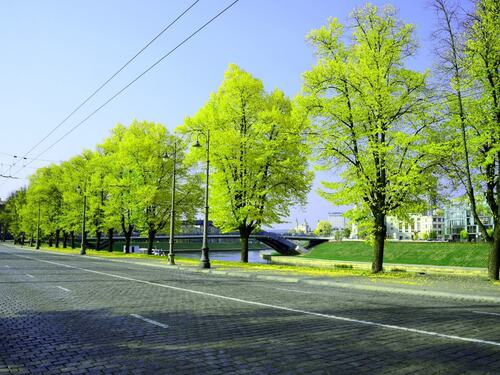
Healthy Green Trees Line a City Street
Selecting the right trees is crucial for successful urban biodiversity initiatives. Here are key factors to consider:
- Climate: Choose species that are well adapted to your local climate conditions. Consider both current climate and future projections.
- Soil type: Urban soils can be compacted or poor in nutrients. Select trees that can thrive in your soil conditions. Conduct a soil test before selecting your trees.
- Available space: Consider both above-ground (height and spread) and below-ground (root system) space, planning for mature size.
- Native vs. nonnative species: While native species are generally preferred for biodiversity, some nonnative species can also contribute positively. Avoid invasive species.
- Pollution tolerance: Some species, like the ginkgo biloba, are particularly adept at handling urban pollution.
- Maintenance requirements: Consider the long-term care needs of different species.
The Top 10 Tree Species for Urban Biodiversity in 2024
- Oak: Supports a vast array of insects, birds, and mammals
- Maple: Provides food for wildlife and beautiful fall colors
- Linden: Excellent for pollinator s, especially bees
- Birch: Attracts a variety of birds and provides interesting bark texture
- Cherry: Offers spring blossoms and fruit for wildlife
- Dogwood: Beautiful flowers and berries that attract birds
- Serviceberry: Multiseason interest and edible berries for humans and wildlife
- Ginkgo: Pollution tolerant and provides unique fan-shaped leaves
- Hornbeam: Tolerant of urban conditions with attractive foliage
- Crabapple: Spring blossoms for pollinators and consistent fruit for winter birds
To assess your local ecosystem needs, consider existing vegetation, local wildlife species and their requirements, urban challenges, and community preferences.
A Step-by-Step Guide to Planting Trees in Urban Areas
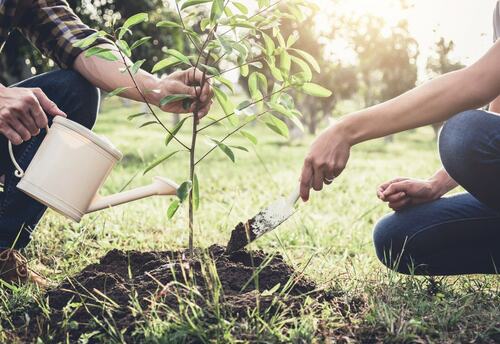
Two People Plant a New Tree Together
Now that you’ve chosen your trees, it’s time to get planting! Follow these steps for successful urban tree planting :
1. Site selection and preparation:
- Choose a location with adequate sunlight and soil
- Check for underground utilities before digging
- Clear the area of debris and competing vegetation
- Assess soil quality and amend if necessary
2. Best practices for tree planting:
- Dig a hole two to three times wider than the root ball but no deeper
- Position the tree at the right depth, with the root flare at ground level
- Gently loosen the roots if they’re circling the root ball
- Backfill with native soil, avoiding amendments in the planting hole
- Create a small berm around the tree to help retain water
- Water thoroughly after planting to eliminate air pockets
3. Essential tools and materials:
- Shovel and spade
- Pruning shears
- Mulch (organic, like wood chips or leaves)
- Watering can or hose
- Stakes and ties (if necessary, but avoid if possible)
- Wheelbarrow for transporting materials
- Work gloves and safety glasses
4. Community involvement:
- Organize tree planting events and make them fun, family-friendly occasions
- Educate neighbors about the benefits of urban trees
- Create “adopt-a-tree” programs for long-term care
- Partner with local schools to incorporate tree planting into environmental education programs
- Use social media to share progress and inspire others to get involved
Remember, proper planting technique is crucial for tree survival and long-term success in urban environments.
Nurturing Your Urban Forest: Care and Maintenance
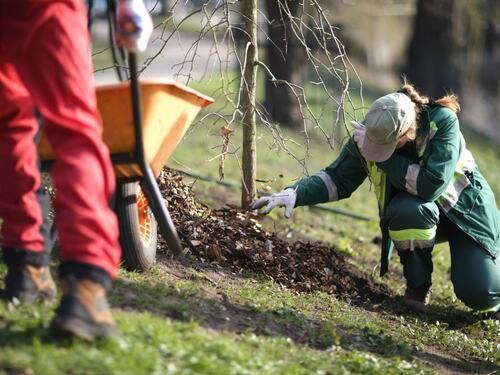
Workers Performing Tree Maintenance in a City Park
Planting is just the beginning. Proper care and maintenance are essential for your urban trees to thrive and maximize their biodiversity benefits.
Watering Schedules and Techniques
- Water deeply and less frequently to encourage deep root growth
- Use a slow-release watering bag for newly planted trees
- Adjust watering based on rainfall and season
- Provide about ten gallons of water per inch or trunk diameter every week during the growing season
- Be especially vigilant during the first two years after planting
Pruning and Shaping for Healthy Growth
- Remove dead, damaged, or diseased branches as soon as you notice them
- Prune for structure in young trees to encourage strong branch architecture
- Avoid overpruning mature trees—remove no more than 25 percent of live branches in a single season
- Prune during the dormant season when possible to minimize stress on the tree
- Always use clean, sharp tools to make clean cuts
Protecting Trees from Urban Stressors
- Install trunk guards to prevent mechanical damage from lawnmowers or string trimmers
- Use permeable pavers around tree bases to allow water infiltration while protecting roots
- Apply a two-to-four-inch layer of organic mulch around the base of the tree, keeping it away from the trunk
- Educate the public about tree care and protection through signage or community outreach
- Be mindful or de-icing salts in winter, which can damage trees—use alternatives when possible
Monitoring Tree Health and Biodiversity Impact
- Regularly inspect trees for signs of stress or disease
- Keep records of tree growth and surrounding wildlife activity
- Collaborate with local arborists or urban foresters for professional assessments
- Use citizen science apps to track and share your observations
Creating Tree-Centric Habitats for Wildlife

A Squirrel Clings to a Tree Trunk
To maximize biodiversity, create diverse habitats around your urban trees:
1. Design Multilayered vegetation structures:
• Incorporate shrubs and ground cover plants beneath trees
• Use a mix of deciduous and
evergreen
species for year-round habitat
2. Incorporate water features and natural elements:
• Add bird baths or small ponds near trees
• Include rock piles or log stacks for insects and small animals
3. Build wildlife corridors through strategic tree placement:
• Connect green spaces with tree-lined paths
• Create “stepping stone” habitats in urban areas
4. Balance human use and wildlife needs:
• Design paths and seating areas that don’t disturb wildlife zones
• Use interpretive signage to educate visitors about urban biodiversity
5. Encourage natural pest control :
• Plant species that attract beneficial insects
• Install bird and
bat houses
to encourage natural predators of problematic insects
• Avoid using chemical pesticides that can harm beneficial insects
Measuring the Impact: Biodiversity Monitoring Techniques
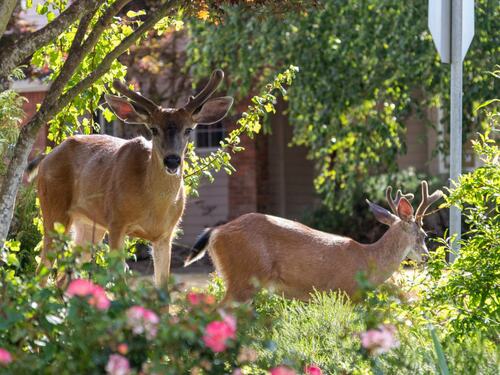
Two Deer Grazing in an Urban Green Space
Tracking the impact of your urban tree planting efforts is crucial for long-term success and continued community support.
Simple Methods for Assessing Biodiversity
- Visual surveys: Regularly observe and record wildlife species around your trees.
- Leaf litter analysis: Examine the variety of insects and microorganisms in fallen leaves
- Bird counts: Conduct periodic bird surveys to track avian diversity
- Pollinator surveys: Monitor the variety and abundance of bees, butterflies, and other pollinators.
- Phenology tracking: Record the timing of natural events like leaf budding, flowering, and fruit production.
Citizen Science Projects for Urban Tree Monitoring
- Join initiatives like iNaturalist or eBird to contribute data to global biodiversity databases
- Organize community “ bioblitz ” events to catalog local species
- Collaborate with local schools for educational monitoring programs
- Participate in national or global urban forest monitoring programs
Using Technology to Track Biodiversity Improvements
- Utilize smartphone apps for species identification and data collection
- Deploy wildlife cameras to capture nocturnal animal activity
- Use GIS mapping to visualize biodiversity changes over time
- Implement acoustic monitoring devices to record and analyze bird and insect sounds
Celebrating and Sharing Your Biodiversity Success Stories
- Create a blog or social media account to share updates and observations
- Host annual “Biodiversity Day” events to showcase your urban forest
- Present findings to local government to support further urban greening initiatives
- Collaborate with social media to share success stories
- Develop educational materials based on your findings
Conclusion
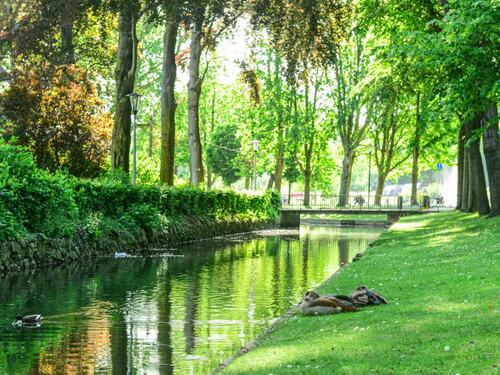
Ducks Rest Beside a Tree-Lined Canal
You’re now equipped with the knowledge to transform your urban landscape into a biodiversity hotspot! Remember, every tree you plant is a step toward a greener, more vibrant city. The impact of your efforts will ripple through the ecosystem, supporting countless species and improving life for all city dwellers—human and nonhuman alike.
As we move through 2024 and beyond, the importance of urban biodiversity will only grow. By planting and caring for trees in our cities, we’re not just creating beautiful green spaces—we’re building resilient ecosystems that can adapt to climate change and support a wide array of life.
Urban forests are more than just a collection of trees; they’re living, breathing communities that connect us to nature and to each other. They provide a sanctuary for wildlife , a classroom for learning, and a place of solace in our busy urban lives.
So grab that shovel, rally your neighbors, and let’s make 2024 the year your city truly comes alive with biodiversity. And remember, whether you’re planting your first tree or managing an entire urban forest, Arborist Now is here to support you every step of the way.
Together, we can create urban forests that future generations will thank us for. The best time to plant a tree was twenty years ago. The second-best time is now. Happy planting!
We may receive affiliate compensation for some of the links below at no cost to you if you decide to make a purchase.


